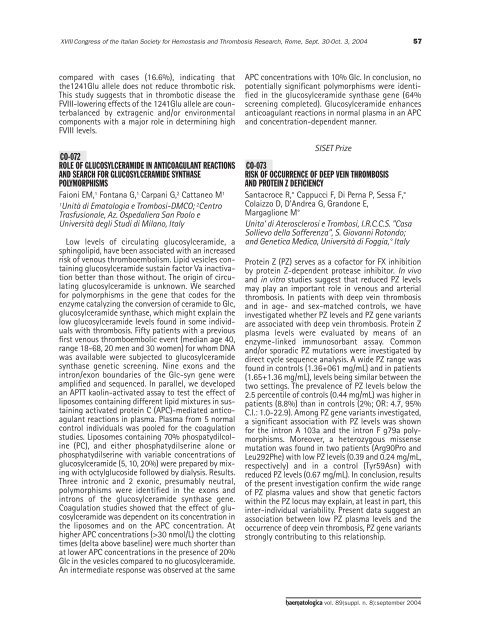Haematologica 2004;89: supplement no. 8 - Supplements ...
Haematologica 2004;89: supplement no. 8 - Supplements ...
Haematologica 2004;89: supplement no. 8 - Supplements ...
- No tags were found...
You also want an ePaper? Increase the reach of your titles
YUMPU automatically turns print PDFs into web optimized ePapers that Google loves.
XVIII Congress of the Italian Society for Hemostasis and Thrombosis Research, Rome, Sept. 30-Oct. 3, <strong>2004</strong>57compared with cases (16.6%), indicating thatthe1241Glu allele does <strong>no</strong>t reduce thrombotic risk.This study suggests that in thrombotic disease theFVIII-lowering effects of the 1241Glu allele are counterbalancedby extragenic and/or environmentalcomponents with a major role in determining highFVIII levels.CO-072ROLE OF GLUCOSYLCERAMIDE IN ANTICOAGULANT REACTIONSAND SEARCH FOR GLUCOSYLCERAMIDE SYNTHASEPOLYMORPHISMSFaioni EM, 1 Fontana G, 1 Carpani G, 2 Cattaneo M 11Unità di Ematologia e Trombosi-DMCO; 2 CentroTrasfusionale, Az. Ospedaliera San Paolo eUniversità degli Studi di Mila<strong>no</strong>, ItalyLow levels of circulating glucosylceramide, asphingolipid, have been associated with an increasedrisk of ve<strong>no</strong>us thromboembolism. Lipid vesicles containingglucosylceramide sustain factor Va inactivationbetter than those without. The origin of circulatingglucosylceramide is unk<strong>no</strong>wn. We searchedfor polymorphisms in the gene that codes for theenzyme catalyzing the conversion of ceramide to Glc,glucosylceramide synthase, which might explain thelow glucosylceramide levels found in some individualswith thrombosis. Fifty patients with a previousfirst ve<strong>no</strong>us thromboembolic event (median age 40,range 18-68, 20 men and 30 women) for whom DNAwas available were subjected to glucosylceramidesynthase genetic screening. Nine exons and theintron/exon boundaries of the Glc-syn gene wereamplified and sequenced. In parallel, we developedan APTT kaolin-activated assay to test the effect ofliposomes containing different lipid mixtures in sustainingactivated protein C (APC)-mediated anticoagulantreactions in plasma. Plasma from 5 <strong>no</strong>rmalcontrol individuals was pooled for the coagulationstudies. Liposomes containing 70% phospatydilcoline(PC), and either phosphatydilserine alone orphosphatydilserine with variable concentrations ofglucosylceramide (5, 10, 20%) were prepared by mixingwith octylglucoside followed by dialysis. Results.Three intronic and 2 exonic, presumably neutral,polymorphisms were identified in the exons andintrons of the glucosylceramide synthase gene.Coagulation studies showed that the effect of glucosylceramidewas dependent on its concentration inthe liposomes and on the APC concentration. Athigher APC concentrations (>30 nmol/L) the clottingtimes (delta above baseline) were much shorter thanat lower APC concentrations in the presence of 20%Glc in the vesicles compared to <strong>no</strong> glucosylceramide.An intermediate response was observed at the sameAPC concentrations with 10% Glc. In conclusion, <strong>no</strong>potentially significant polymorphisms were identifiedin the glucosylceramide synthase gene (64%screening completed). Glucosylceramide enhancesanticoagulant reactions in <strong>no</strong>rmal plasma in an APCand concentration-dependent manner.SISET PrizeCO-073RISK OF OCCURRENCE OF DEEP VEIN THROMBOSISAND PROTEIN Z DEFICIENCYSantacroce R,° Cappucci F, Di Perna P, Sessa F,°Colaizzo D, D'Andrea G, Grandone E,Margaglione M°Unita' di Aterosclerosi e Trombosi, I.R.C.C.S. "CasaSollievo della Sofferenza", S. Giovanni Rotondo;and Genetica Medica, Università di Foggia,° ItalyProtein Z (PZ) serves as a cofactor for FX inhibitionby protein Z-dependent protease inhibitor. In vivoand in vitro studies suggest that reduced PZ levelsmay play an important role in ve<strong>no</strong>us and arterialthrombosis. In patients with deep vein thrombosisand in age- and sex-matched controls, we haveinvestigated whether PZ levels and PZ gene variantsare associated with deep vein thrombosis. Protein Zplasma levels were evaluated by means of anenzyme-linked immu<strong>no</strong>sorbant assay. Commonand/or sporadic PZ mutations were investigated bydirect cycle sequence analysis. A wide PZ range wasfound in controls (1.36+061 mg/mL) and in patients(1.65+1.36 mg/mL), levels being similar between thetwo settings. The prevalence of PZ levels below the2.5 percentile of controls (0.44 mg/mL) was higher inpatients (8.8%) than in controls (2%; OR: 4.7, 95%C.I.: 1.0-22.9). Among PZ gene variants investigated,a significant association with PZ levels was shownfor the intron A 103a and the intron F g79a polymorphisms.Moreover, a heterozygous missensemutation was found in two patients (Arg90Pro andLeu292Phe) with low PZ levels (0.39 and 0.24 mg/mL,respectively) and in a control (Tyr59Asn) withreduced PZ levels (0.67 mg/mL). In conclusion, resultsof the present investigation confirm the wide rangeof PZ plasma values and show that genetic factorswithin the PZ locus may explain, at least in part, thisinter-individual variability. Present data suggest anassociation between low PZ plasma levels and theoccurrence of deep vein thrombosis, PZ gene variantsstrongly contributing to this relationship.haematologica vol. <strong>89</strong>(suppl. n. 8):september <strong>2004</strong>
















